Kill Screen Magazine's Blog, page 262
June 15, 2015
My God, Cuphead still looks beautiful
A new trailer showcases the animated stunner in action.
Paint the screen with glitches in this virtualization of our chaotic online lives
A virtual storm of emoticons and floppy disks.
In the Game of Thrones season finale, you either win, or you respawn
Spoiler warning for everyone who is not caught up on season five
///
A few episodes ago, in yet another classic Stannis-Davos argument, the false king declared his strategic position—while also basically summing up the entirety of the Game of Thrones fiction: "We march to victory, or we march to defeat. But we go forward. Only forward."
To a great extent, the forward momentum of the plot is how Game of Thrones sinks its hooks into us. As the titular allusion suggests, the fiction unfolds with the same kind of inertia as a game. The threat and possibility of winning or losing drives the players forever onward. As an audience, we know that, no matter how meandering the narrative might feel (particularly for book readers), winter is coming. Even for the characters who do not fully grasp what those words mean, the threat hangs high.
the fiction unfolds with the same kind of inertia as a game
Each story line moves with the momentum of a freight train, the characters all battling their own imminent failures and possible gains. Whether it's Sansa, Littlefinger, Brienne, Stannis, Jon Snow, or Dany, everyone marches forward into some gamble they cannot turn back from. Even Cersei must soldier on, moving toward her singular goal, regardless of what challenges are flung at her. No matter who the character is, the rules of the fiction—the fact that, in the game of thrones, you either win or you die—dictate the players path. For several characters throughout the season five finale, they must only move forward because turning back is defeat as much as soldiering on means defeat.
With the (seemingly final) moments of Stannis Baratheon, Game of Thrones once again establishes that—before even sexposition—this is a story primarily about war and strategy. The birds-eye angle of the battlefront rendered viewers of the HBO show essentially players of a Civilization game. Do your soldiers scatter in the face of defeat, or do they cry out in fidelity before pushing onward into death?
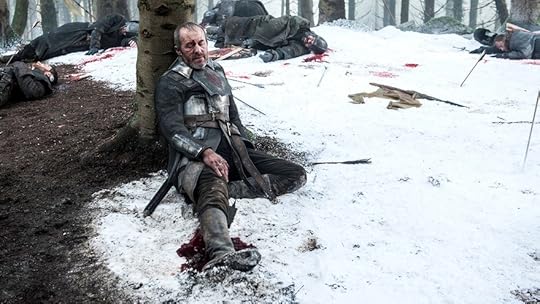
Part of Stannis' military brilliance comes from this kind of relentless progression path. He'd drag his men through hell and back, even if it meant the slightest chance at a narrow victory. As evidenced by his final battle, however, his stubbornness as a player proves his ultimate undoing, revealing the pitfalls of an inflexible character in a game that demands turn-by-turn strategies. Because, say we called this a game of Dungeons and Dragons rather than a "game of thrones," can you imagine a player that, after his attempt to use blood magic is so ineffective, insists on continuing with that same plan as if it had worked?
As with Varys advice to Tyrion, when it comes to the game of thrones, we've seen that "information is the key. You need to learn your enemies strengths and strategies." The problem with Stannis—and perhaps even Cersei's tactics—is spending too much time considering their own motivation and tactic rather than keeping their eyes on the armies circling into formation around them.
As the finality of death claims yet another fan favorite
There's one key difference between the defeats in Game of Thrones versus videogames. Characters of the game of thrones do not respawn after failure (unless you're Dondarrion, of course). Failure is final. As the finality of death claims yet another fan favorite, many are already attempting to create a respawn theory. After all, fans are saying, didn't Qyburn just resurrect the Mountain in this episode? Why would Melisandre return? Not even confirmation from actor Kit Harrington will placate the masses on this one.

But constructing theories on Jon coming back as "Snow, the local friendly white walker," is missing the point entirely. In the Game of Thrones fiction, characters can only respawn through lineage. As Jamie's touching-turned-terrible scene with Myrcella and Dany's frustrated dialogue with Drogon shows, our children either choke out or let our dreams soar. Through them and them alone, we see a path forward—a way to survive a game where you either win or you die.
We cannot hope that Ned Stark's head will get sown back onto his body only to can carry on yelling about duty and winter. At best, we can hope Ned's ideals, strategies, and verbiage live on through the children he helped raise. Of course, we've seen Jon Snow take up the mantel as a pouty, unpopular do-gooder. And we've seen him die for it just like Ned did. But as a father of sorts (or at the very least, a leader) himself, Jon Snow has left behind his own seeds to carry out his life's work. We can only hope the wildlings fair better than the pretty crow did when it comes to the viral army of white walkers moving ever closer to Westeros.
The disembodied racer at the heart of Project CARS
Racing cars in a lonely world.
The astonishing riddle that started inside Trials Evolution ended up spanning the globe
The racing game Trials Evolution was released for Xbox 360 in the spring of 2012. It was well reviewed. It sold reasonably well. It was notable in the sense that all games are notable to someone. Then something strange happened.
Actually, a lot of strange things happened. Wooden planks inscribed with letters could be found within the game world. Combined, those planks contained an encrypted code. Once deciphered, that code revealed a secret move, which revealed a song, which…you can see where this is going. Trials Evolution is the Matryoshka doll of riddles.
the Matryoshka doll of riddles.
A group of online sleuths formed. Of course one did; that’s how mysteries are solved these days—or at least how many people attempt to solve them. Digital collaborators searched far and wide for MH370. More recently, Digital Globe’s crowdsourcing platform Tonmod was used by civilians to sift through satellite images of the wreckage caused by a 7.8 magnitude earthquake in Nepal. In a similar vein, the detectives working on Trials Evolution were—and still are—distributed around the globe and brought a range of skills to the table.

One of those detectives is a man by the name of Brad Hill. He also goes by “Professor FatShady.” He's written up the findings of those looking into the Trials Evolution for Kotaku. It’s a story spanning mediums and continents. One that involves digging up the dry soil of San Francisco four times, visiting the grave of a man called Henry Herbert Hale in Bath, UK, discovering an antique pocket watch from 1916 in Helsinki, and recovering a small key with a key with a metal plaque that reads "It seemed like forever ago" from under a bridge in Sydney, Australia.
Hill offers most of the answers to the riddles, which, in turn, only beg further questions. But he has the closest thing we’ll get to answers any time soon. It’s a fantastic yarn spanning in-game action and IRL sleuthing called “The Trials Evolution Riddle Has Been Solved And It Is Truly Unbelievable.” Normally such a title would be (rightly) dismissed as hyperbole. In this case, however, it's entirely warranted. Go read it now.
June 12, 2015
The human cost of Baku 2015, conceptualized as the most futile videogame ever
A game of human rights violations.
As beautiful as ABZ�� is it does not forget the deep terrors of the ocean
If you have a child, do not take them on vacation to the cold Cornwall coasts. It is a place of terror. Dark rugged waves that foam at the mouth aggressively pound steep rocks to a deafening chorus. On the wet sand lies the receding tide's victims: purple blobs of dead jellyfish, scattered like alien fertilizer. One of them stung my cousin's thigh in the water. I remember watching as she screamed with pain while the venom swelled like brambles in her vessels. She was rushed to a doctor soon after.
the beauty of all the underwater traffic.
When younger, the ocean didn't scare me as much as its wildlife did. My mother told me to think of it as a gigantic bath. But there are creatures in there. And they can swim up your shorts with teeth and claws. It's not an invasion I wanted to force upon myself. Even as an eighteen-year-old, wading into the Mediterranean Sea during Turkey's unbearable summer heat, I was apprehensive. I was right to be, too, as that effort ended after a crab pinched my toes.
As I've grown older, that terror has transmogrified into a fascination with just how teeming with life the ocean is. There's a lot going on in there. This is something that underwater exploration game ABZÛ seems to capture, on both a large and small scale, realizing the beauty of all the underwater traffic. There are schools of fish that you can swim alongside at the press of a button. Turtles and manta rays can can be clung to for a ride, again, at the touch of a button. There's a whole ecosystem to explore, apparently comprised of tens of thousands of fish, all of which have their own routines and behaviors to interact with.
With it all being preened into existence under the insightful eye of Matt Nava, it is luxurious to look at too. Nava is the former art director on thatgamecompany's Journey but is less at home with that game's secluded deserts than he is with ABZÛ's undersea life. As he told Kill Screen previously, he started scuba diving at a young age, and has grown a love for oceanic landscapes and all they hold. In a word, he describes the ocean as "majesty." As the new screenshots of ABZÛ show, Nava seems to have blown that word up and painted its letters with shimmering colors.
the seabed is still mostly an uncharted mystery to us.
But recent hands-on previews of ABZÛ delve into the game's underbelly. Something I learned over the years was that the billions of fish swimming just under the water's surface was nothing compared to what lies much further down. We don't know what it is and that's what makes it scary yet engrossing. H.P. Lovecraft found horror in this unknown space when inventing the city of R'lyeh that is sunken somewhere at the bottom of the South Pacific. It is described as a "nightmare corpse-city," and one that is comprised of architecture made of "nothing less than the tangible substance of earth's supreme terror." And, of course, it is where the mighty Cthulhu and his hordes are ensnared.
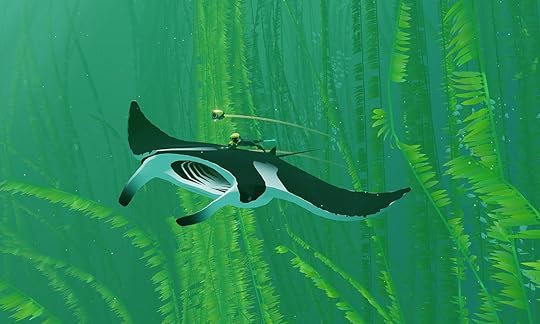
Closing in on a century later, the seabed is still mostly an uncharted mystery to us. There are ancient oceanic trenches that we haven't got close to touching yet. Anything could be in there, even the unimaginable terrors that Lovecraft so famously had us try to fathom with his words. Just last year, the Malaysian Airlines flight MH370 disappeared into the depths of the ocean and hasn't been retrieved. This is on account of only 0.05 percent of the ocean floor having been mapped to a level that's useful enough to track wreckages like that. It means a whole planeload of people can be swallowed up by the Indian Ocean. Just gone.
This type of mystery comprises the darker side of ABZÛ. Being set in the ocean and involving the exploration of it, it cannot and does not ignore the terror inherent in such a voluminous unknown. And so, there are vast spaces with no apparent surface to find, only fading water in every direction. There are also drones that can be repaired and sent to research mineral pools. But they are also fodder to the sharks that share the same waters. Go far enough down and totemic statues emerge. How did they get there? Who carved them? This is the start of the story beyond ABZÛ's beauty and it's what should keep us swimming downwards to, perhaps, where we shouldn't.
You can find out more about ABZÛ on its website. You can see its new screenshots above and below.
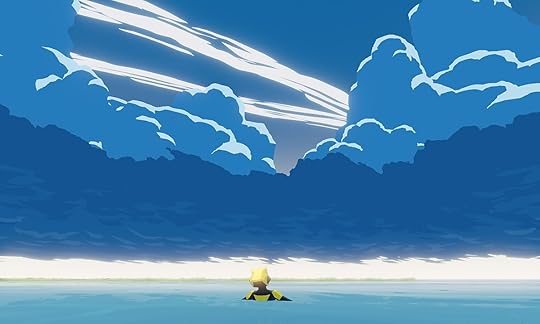
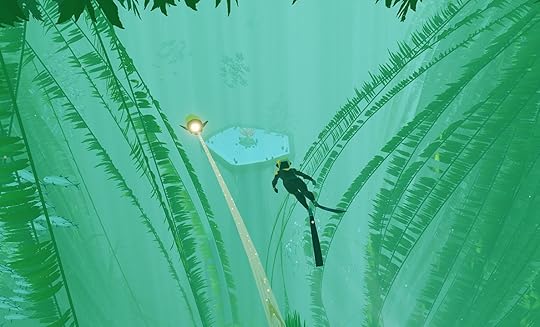
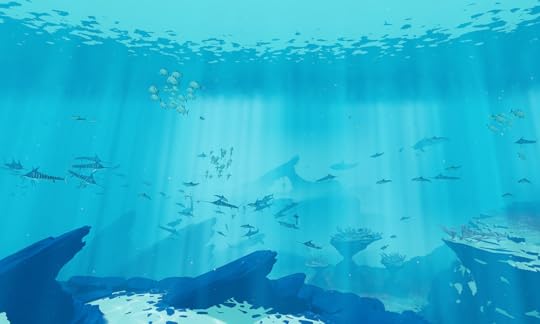
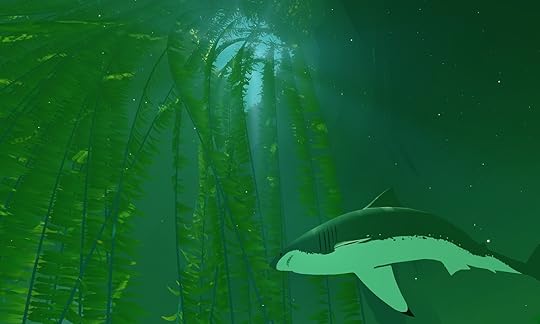
Bloody Histories, Dangerous Communities: Educators��� Ethical Responsibilities Teaching Games
The moral dilemma of teaching with games.
An exhibit celebrates the brutalist playgrounds of the past, as should we all
Brutalism gets a bad name. Ok, let’s be honest, it has a bad name. If tomorrow morning you were tasked with encouraging parents to send their kids to a specific playground, you probably wouldn’t call it brutalist.
Or would you? For a brief, wonderful moment in the middle of the 20th century, architects and planners endeavored to design brutalist playgrounds, and the results were often wonderful. These playgrounds are now the subject of an exhibit at the Royal Institute of British Architects (RIBA) by the Assemble collective and artist Simon Terrill. To mark the occasion, The Guardian has a series of images from the exhibit on its site. Go look at them. The rest of this article, like a concrete play structure, will still be here waiting for your return.
While brutalist playgrounds were cast from concrete, they were no more (and probably less) prescriptive than those that followed in their stead. The playground images in RIBA’s exhibit as well as the foam playground created by Terrill and Assemble are, for the most part, abstract collections of shapes, steps, and tunnels. The exact meaning and uses of all these parts was up to their users. Compared with contemporary playgrounds, their tree houses that look like tree houses and clearly indicated passageways, this is what freedom looks like.
In her essay, “The Overprotected Kid,” The Atlantic’s Hanna Rosin observes, “Kids once took special pride in “knowing how to get places” alone, and in finding shortcuts adults normally wouldn’t use.” Note the use of past tense in that quote; Rosin contends that this sort of freedom has been lost to the obsessive forces of ‘safety.’ The hard edges of the concrete playground do not scream safety and have largely disappeared, but at what cost? Is a slight reduction in the number of scraped knees really enough of benefit to justify a childhood spent in a stunningly literal world?
This is what freedom looks like.
The value of the brutalist playground is not, however, limited to child’s play. In this weekend’s New York Times Magazine, Alexandra Lange asked seven prominent architects to mount defenses of buildings that have been panned. Lot-Ek’s Ada Tolla stood up for the Vele di Scampia in Naples, Italy. She explained: “None of the planned public spaces, amenities, schools or offices were ever constructed… For me it is important to recognize that the Vele is not a failure of the architecture, but rather a failure in execution and management.”
Though the Vele is not a brutalist building, Tolla’s takeaways extend to the playgrounds in RIBA’s exhibit. Brutalist complexes are often derided as harsh and unwelcoming, sometimes justifiably so, but many of these judgements take place in a vacuum. Brutalist playgrounds, like those that weren’t built in the Vele, were meant to humanize their broader environs, to make them more obviously hospitable to human life. The harsh edges of concrete can indeed be softened by more concrete.
Remembering Jurassic Park: Trespasser, the trainwreck that made shooting dinosaurs feel like a chore
Killing dinos with wacky waving inflatable aiming arms.
Kill Screen Magazine's Blog
- Kill Screen Magazine's profile
- 4 followers



